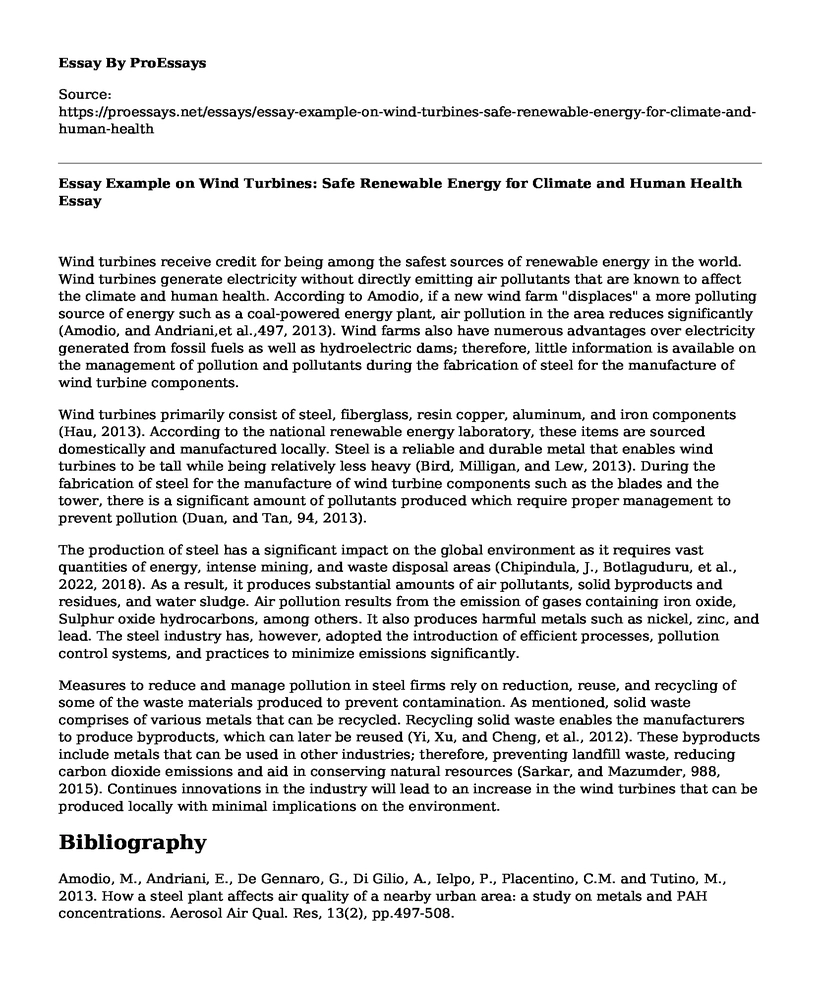Wind turbines receive credit for being among the safest sources of renewable energy in the world. Wind turbines generate electricity without directly emitting air pollutants that are known to affect the climate and human health. According to Amodio, if a new wind farm "displaces" a more polluting source of energy such as a coal-powered energy plant, air pollution in the area reduces significantly (Amodio, and Andriani,et al.,497, 2013). Wind farms also have numerous advantages over electricity generated from fossil fuels as well as hydroelectric dams; therefore, little information is available on the management of pollution and pollutants during the fabrication of steel for the manufacture of wind turbine components.
Wind turbines primarily consist of steel, fiberglass, resin copper, aluminum, and iron components (Hau, 2013). According to the national renewable energy laboratory, these items are sourced domestically and manufactured locally. Steel is a reliable and durable metal that enables wind turbines to be tall while being relatively less heavy (Bird, Milligan, and Lew, 2013). During the fabrication of steel for the manufacture of wind turbine components such as the blades and the tower, there is a significant amount of pollutants produced which require proper management to prevent pollution (Duan, and Tan, 94, 2013).
The production of steel has a significant impact on the global environment as it requires vast quantities of energy, intense mining, and waste disposal areas (Chipindula, J., Botlaguduru, et al., 2022, 2018). As a result, it produces substantial amounts of air pollutants, solid byproducts and residues, and water sludge. Air pollution results from the emission of gases containing iron oxide, Sulphur oxide hydrocarbons, among others. It also produces harmful metals such as nickel, zinc, and lead. The steel industry has, however, adopted the introduction of efficient processes, pollution control systems, and practices to minimize emissions significantly.
Measures to reduce and manage pollution in steel firms rely on reduction, reuse, and recycling of some of the waste materials produced to prevent contamination. As mentioned, solid waste comprises of various metals that can be recycled. Recycling solid waste enables the manufacturers to produce byproducts, which can later be reused (Yi, Xu, and Cheng, et al., 2012). These byproducts include metals that can be used in other industries; therefore, preventing landfill waste, reducing carbon dioxide emissions and aid in conserving natural resources (Sarkar, and Mazumder, 988, 2015). Continues innovations in the industry will lead to an increase in the wind turbines that can be produced locally with minimal implications on the environment.
Bibliography
Amodio, M., Andriani, E., De Gennaro, G., Di Gilio, A., Ielpo, P., Placentino, C.M. and Tutino, M., 2013. How a steel plant affects air quality of a nearby urban area: a study on metals and PAH concentrations. Aerosol Air Qual. Res, 13(2), pp.497-508.
Bird, L., Milligan, M. and Lew, D., 2013. Integrating variable renewable energy: Challenges and solutions (No. NREL/TP-6A20-60451). National Renewable Energy Lab.(NREL), Golden, CO (United States).
Chipindula, J., Botlaguduru, V.S.V., Du, H., Kommalapati, R.R. and Huque, Z., 2018. Life cycle environmental impact of onshore and offshore wind farms in Texas. Sustainability, 10(6), p.2022.
Duan, J. and Tan, J., 2013. Atmospheric heavy metals and arsenic in China: situation, sources and control policies. Atmospheric Environment, 74, pp.93-101.
Hau, E., 2013. Wind turbines: fundamentals, technologies, application, economics. Springer Science & Business Media.
Sarkar, S. and Mazumder, D., 2015. Solid waste management in steel industry-challenges and opportunities. Int J Soc Behav Educ Econ Bus Indust Eng, 9(3), pp.978-981.
Yi, H., Xu, G., Cheng, H., Wang, J., Wan, Y. and Chen, H., 2012. An overview of utilization of steel slag. Procedia Environmental Sciences, 16, pp.791-801.
Cite this page
Essay Example on Wind Turbines: Safe Renewable Energy for Climate and Human Health. (2023, May 08). Retrieved from https://proessays.net/essays/essay-example-on-wind-turbines-safe-renewable-energy-for-climate-and-human-health
If you are the original author of this essay and no longer wish to have it published on the ProEssays website, please click below to request its removal:
- Architectural Design Digital Change Paper Example
- The Significance of Flint Towards Environmental Injustice - Essay Sample
- Essay on Evidence of Global Warming
- Essay Example on Arctic Biota at Risk: Competing Interests vs. Survival
- Essay Sample on Reusable Coffee Cups: An Eco-Friendly Solution
- Research Paper on Nanotech: Revolutionizing Industries with Nanomaterials
- Essay Example on AI and Big Corps Collaborate to Achieve Sustainability Goals







